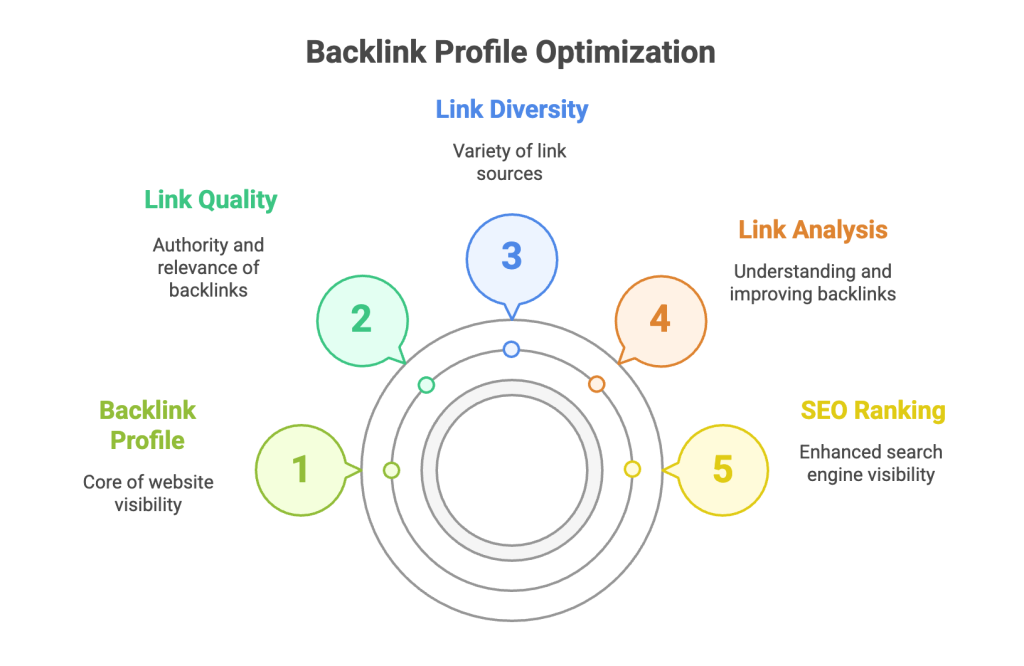Are you wondering what is a backlink profile? A backlink profile is the complete record of all incoming links (backlinks) from other websites to your website, serving as a crucial factor for search engine optimization (SEO) that influences your website’s authority and rankings.
It includes details about the quantity, quality, and relevance of these links, as well as the anchor text (the clickable text) used, and the overall diversity of the linking sources.
A strong, healthy backlink profile indicates trustworthiness and relevance, boosting a site’s credibility and visibility in search results, while a weak or poor one can negatively impact performance and may lead to a penalty by search algorithms.
Moreover, it will lead to an unsustainable strategy and impact on your long-term business growth.
Understanding your backlink profile is crucial in SEO for building authority, boosting rankings, and driving traffic by identifying valuable, high-quality links while spotting and disavowing toxic or low-quality ones.
Apart from that, you have more control over your link acquisition strategy, which enhances your link-building for sustainable growth.
A strong profile will enhance a site’s credibility as a trusted source and provide the authority needed to rank higher in search results, ultimately improving overall online presence and performance.
In this article, we’ll dive deep into what a backlink profile is, why it’s important, and provide insight into how to establish a robust backlink profile that drives sustainable growth and long-term SEO success.
Understanding Backlink Profiles

Backlinks are links from one website to another, serving as “votes of confidence” or endorsements that signal your content is valuable and authoritative to search engines like Google. Search engines use backlinks as a trust and authority signal, making high-quality links crucial for ranking longevity.
Their primary role in SEO is to enhance search engine rankings, build domain authority, and drive referral traffic. But quality and relevance are key; acquiring high-quality backlinks from authoritative and relevant websites is more valuable than a large number of low-quality links from unrelated or spammy sites.
The best practice to build a robust backlink profile is to implement the white hat link-building strategy and ensure that you acquire links from reputable sources in your niche.
Integrating this technique into your link-building campaign will drive sustainable growth for your business website by driving more organic traffic, increasing ranking position in the SERPs, and generating more leads and sales.
There are several backlink profile’s key components you should know, those include the quality and relevance of the linking sites, the quantity of backlinks, the diversity of referring domains (the unique websites linking to yours), and the variation in anchor text (the clickable words of a link).
Other components are the balance of dofollow vs. nofollow links, the natural growth rate (link velocity), and the presence of any toxic or spammy links that could harm your SEO.
Here are the Key Components of a Backlink Profile
- Total Backlinks: Overall number of links pointing to your site.
- Referring Domains: Unique websites linking to you.
- Domain Authority/Rating (DA/DR): Strength of the linking domain.
- Page Authority/URL Rating (PA/UR): Power of the linking page.
- Anchor Text Distribution: Variety of anchor texts (branded, generic, exact/partial match).
- Link Relevance: Topical similarity between the linking site and your site.
- Dofollow vs. Nofollow: Balance of equity-passing and non-equity links.
- Link Placement: Contextual (in-content) vs. sidebar/footer links.
- Link Velocity: Natural pace of link growth over time.
- Link Diversity: The mix of blogs, news, forums, directories, etc.
- Geographic Location: Origin country of linking sites (important for local SEO).
- Active vs. Lost Links: Monitoring live vs. removed/broken backlinks.
- Spam/Toxic Links: Risky links from spammy or low-quality sites.
- Referral Traffic: Visitors coming through backlinks.
- Brand Mentions with Links: Branded citations strengthen authority.
What is a Spammy link?
A spammy link is a backlink from a low-quality, irrelevant, or untrustworthy website created to manipulate search engine rankings, rather than provide genuine value to users.
Key indicators of a spammy link include coming from unrelated websites, sites with poor content, excessive or unnatural keyword usage in the anchor text, rapid and large-scale creation, or links in comment sections and forums that are out of context.
Such links come from black-hat SEO tactics like paid link schemes and automated programs, low-quality PBN acquisition, as well as from malicious negative SEO attacks.
Common Examples of Spammy Links
- Comment Spam: Irrelevant links added to blog comments or forum posts.
- Link Farms: Websites designed to have a large number of links with no real content.
- Paid Link Schemes: Buying or selling links with the intent to manipulate rankings.
- Automated Programs: Using software to generate a large volume of links.
- Excessive Link Exchanges: Trading links on a massive, unnatural scale.
- Negative SEO: Maliciously building spammy links to a competitor’s site to harm their rankings.
Why Spammy Links Are Harmful
- Search Engine Penalties: Google penalizes websites that use spammy links, which can lead to lower rankings or removal from the search index.
- Compromised Credibility: Such links undermine the trustworthiness and reputation of the linking site and the website they point to.
- Poor User Experience: Users may encounter malicious websites, compromised privacy, or simply be led to irrelevant content.
Importance of Backlink Profiles
Backlinks improve search engine rankings by signaling to Google that your website is credible and authoritative through high-quality backlinks from relevant sites, acting as digital endorsements for your content’s value and trustworthiness.
Google’s algorithm interprets these links to boost your site’s visibility and position on search engine results pages (SERPs).
Backlinks enhance website authority and credibility by acting as endorsements from other sites, signaling to search engines that your content is valuable and trustworthy. According to a study, a website with a strong backlink profile ranks 40% higher than one that only has good on-page optimization.
A strong backlink profile, especially with links from high-quality, reputable sources, improves search engine rankings, increases organic traffic, and builds user trust by association with authoritative domains.
Backlinks play a crucial role in driving organic traffic by acting as votes of confidence that boost a website’s authority and search engine rankings, leading to greater visibility and more clicks from users. According to the data statistics, 92% of top-ranking websites have at least one backlink.
Acquiring high-quality backlinks from authoritative and relevant websites not only improves a site’s credibility but also generates direct referral traffic as users click through to learn more.
This combination of higher rankings and direct traffic significantly increases the potential for customers and helps achieve business goals.
Apart from that, backlinks are crucial to a digital marketing strategy because they improve Search Engine Optimization (SEO) by acting as a vote of confidence that increases website authority and search rankings, drives high-quality referral traffic from trusted sources, boosts brand visibility and credibility, and ultimately enhances conversion rates.
Note:
A strong backlink profile is built with links from reputable sources and relevant websites. It is a foundational element that helps a website compete effectively in the digital landscape.
Analyzing and Improving Your Backlink Profile

There are so many tools that help you analyze your backlink profile. Top tools for backlink profile analysis include comprehensive platforms like Ahrefs, Semrush, and Moz, which offer in-depth data on backlinks, referring domains, anchor text, and competitor analysis.
Google Search Console provides essential, free access to your own site’s backlinks, while free alternatives like Ahrefs Backlink Checker and OpenLinkProfiler allow for basic analysis and competitor insights.
To identify toxic backlinks, you can use backlink tools like Semrush or Google Search Console to find links from low-authority, irrelevant, or spammy sites with poor content, unusual anchor text, or excessive linking from the same domain.
Then, create a list of spammy sites for disavowal and remove them from the Google index to stay ahead of penalties by Google algorithms.
To disavow them, create a text (.txt) file listing the URLs or domains to ignore, then upload this file to the Disavow Tool within Google Search Console to tell Google to disregard these links.
Here is the disavow process:
- Compile a List of Toxic Links: Use your SEO tool’s reports or GSC to identify the specific URLs or domains you want to disavow.
- Create a Disavow File: Open a plain text editor and create a new file.
- Format the File:
- Each entry (URL or domain) should be on a new line.
- Use the domain: prefix for disavowing all links from a domain (e.g., domain:example.com).
- For a specific URL, list the full URL (e.g., http://spamysite.com/badlink).
- Save the File: Save the file as a .txt file (e.g., disavow.txt) and ensure it’s UTF-8 or 7-bit ASCII encoded.
- Upload to Google Search Console:
- Go to the Disavow Links tool in your Google Search Console account.
- Select your website property.
- Upload your disavow file.
There are ways that help you build a robust backlink profile, such as creating high-quality, link-worthy content like original research and linkable assets. Then, promote this content through guest posting, broken link building, digital PR, and competitor analysis.
Finally, ensure your profile is healthy by performing regular audits, disavowing toxic links, and fostering a natural growth pattern from relevant, authoritative sources.
- Create Link-Worthy Content
- High-Quality Content: Produce in-depth articles, infographics, case studies, and original research that provide unique value and solve your audience’s problems.
- Linkable Assets: Develop unique, valuable content, such as studies, tools, or comprehensive guides that others will naturally want to reference and link to.
- Acquire Links Through Strategic Tactics
- Guest Posting: Write guest posts for relevant, high-authority websites in your industry to gain exposure and earn a backlink.
- Broken Link Building: Find broken links on other websites and suggest your valuable content as a replacement.
- Digital PR: Leverage news mentions and earned media to gain backlinks from reputable news sites and publications.
- Skyscraper Technique: Find high-ranking content in your niche, then create a superior, more comprehensive version and reach out to those linking to the original.
- Competitor Analysis: Analyze your competitors’ backlinks to find opportunities for links you can also acquire.
- Resource Page Backlinks: Find resource pages and suggest your content as a valuable addition to their list.
- Promote Your Content
- Email Outreach: Conduct personalized email outreach to other site owners and influencers, offering value and making a compelling case for linking to your content.
- Social Media Promotion: Share your link-worthy content across social media platforms to increase visibility and attract potential linkers.
- Maintain Your Backlink Profile
- Regular Audits: Use SEO tools to periodically review your backlink profile and identify any toxic or harmful links.
- Disavow Toxic Links: Use tools like Google’s Disavow Tool to remove harmful backlinks that could negatively impact your site.
- Seek Natural Growth: Aim for a consistent, natural rate of acquiring links rather than sudden spikes, which can appear unnatural to search engines.
- Diversify Your Links: Acquire backlinks from a variety of sources, including blogs, news sites, forums, and directories, to establish a robust and natural profile.
Conclusion
A strong backlink profile is one of the cornerstones of sustainable SEO success. It not only boosts search visibility but also establishes credibility and authority in your niche.
Regularly monitoring and refining your backlink profile ensures you maintain quality links, avoid harmful ones, and stay ahead of competitors.
As search engines continue to evolve, so does the role of backlinks in ranking strategies. By staying proactive, analyzing, optimizing, and adapting.
You can establish a robust site’s authority and set a solid foundation for long-term growth in the ever-changing world of SEO.
Share via:

